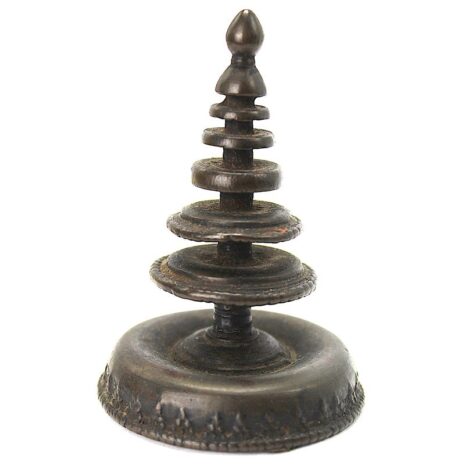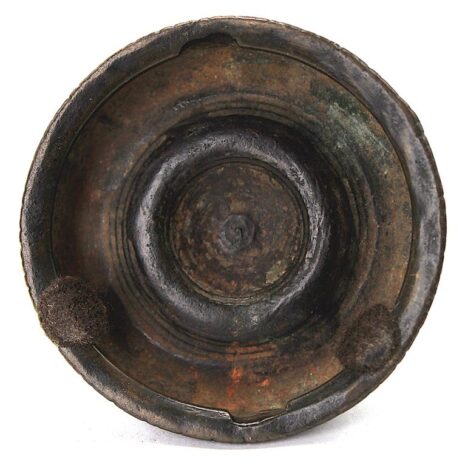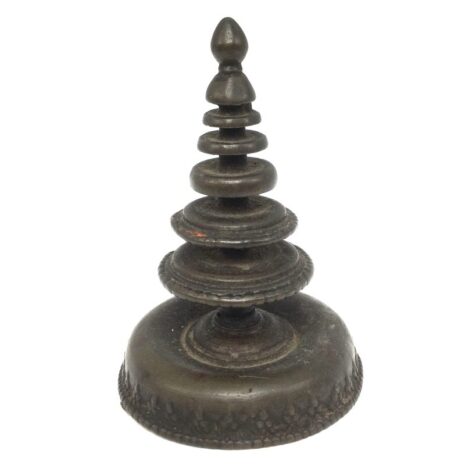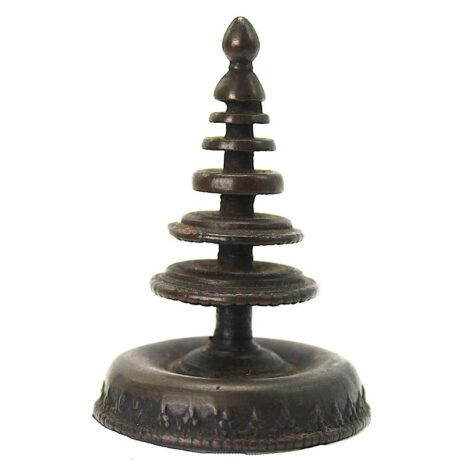Antique Bronze Miniature Stupa/Pagoda, Nepal (3207)
Original price was: $425.00.$350.00Current price is: $350.00.
H: 3.5″ Dia 2.5″ | FREE SHIPPING WITHIN CONTINENTAL U.S.
Hand-made metal Nepalese 7-level stupa/pagoda with decorative details around the base and round eaves with scalloped edges used for personal worship.
Description
A stupa is a memorial shrine and a sacred burial mound to house sacred relics associated with the Buddha or other Buddhist saintly persons, a symbol of the Buddha’s enlightenment and a model of the Buddhist cosmos (McArthur, p. 179). Initially they were hemispherical mound-like shapes and were transformed in East Asia into a pagoda – a multi-tiered tower with eaves or roofs projected outward from a central structure. The oldest stupa in Nepal is at Swayambhunath in the Kathmandu Valley (circa 5th century CE) topped with a 13-tier pagoda. Small reliquaries, stupas and pagoda-shaped pieces without relics in wood and metalwork began to be made for personal worship for the faithful to be placed on home altars along with statues and other spiritual objects as reminders that enlightenment is available to all sentient beings. These were placed on home altars and shrines along with the Buddha, bodhisattvas, monks and other Buddhist objects.
This object is a hand-made metal 7-level stupa/pagoda with decorative details around the base. Two of the round eaves have scalloped edges. In many Buddhist cultures, smaller stupas or pagodas are used for personal worship, usually from wood, stone or [more rarely] bronze.” (McArthur, p. 159). This was purchased in the 1970’s in Kathmandu from an antiques dealer.
Meher McArthur, Reading Buddhist Art: An Illustrated Guide to Buddhist Signs and Symbols, London, Thanes and Hudson, 2002.
Additional information
| Weight | 3 lbs |
|---|---|
| Dimensions | 6 × 6 × 6 in |
| Place of Origin | Nepal |
| Period | Antique (1200-1920) |
| Date | 18th century |
| Materials and Technique | Bronze/brass/copper alloy |
| Dimensions (inches) | Ht: 3.25” Dia: 2.25” |
| Dimensions (metric) | Ht: 36.83cm W: 16.51 D: 13.97 |
| Condition | Very good, wear consistent with age and use/no restorations/repairs |
| Item Number | 3207LME |
| Shipping Box Size |








